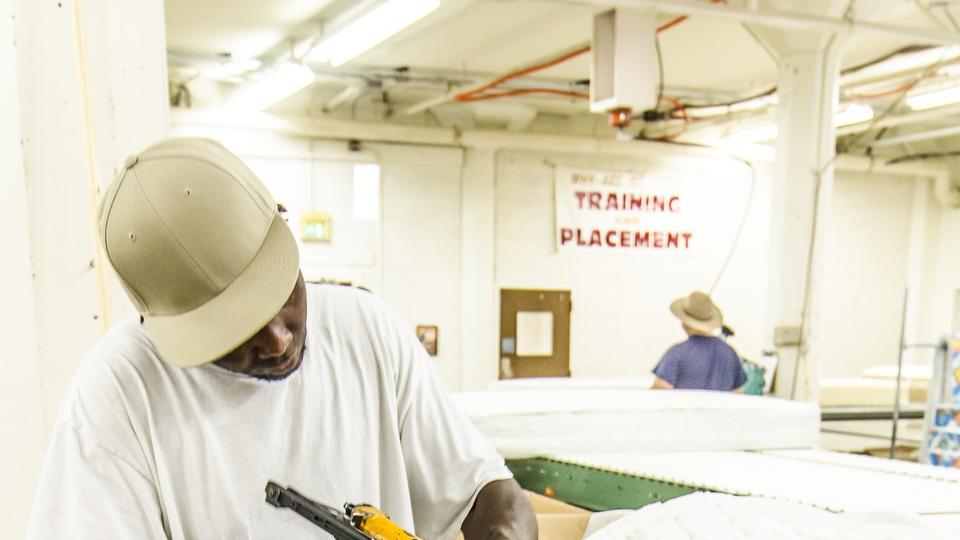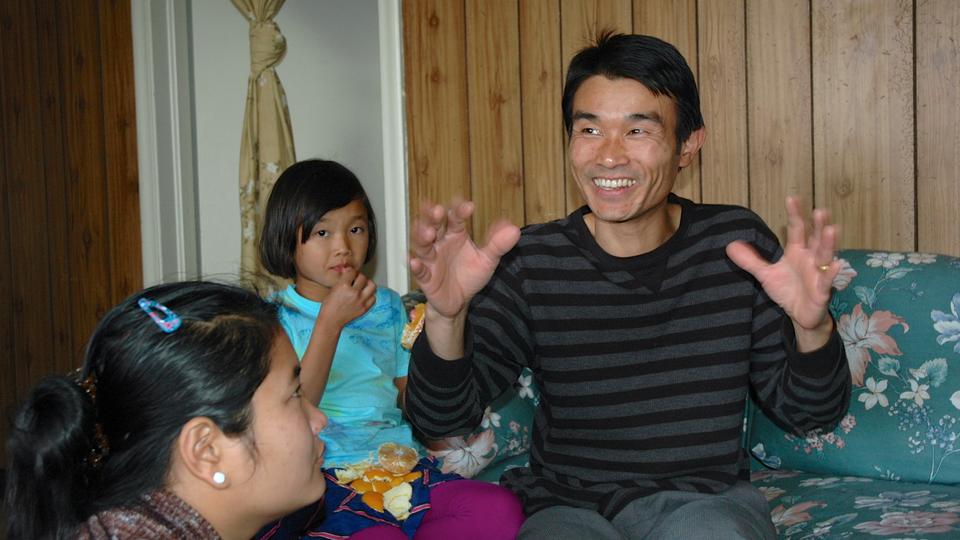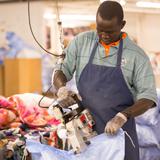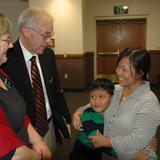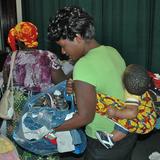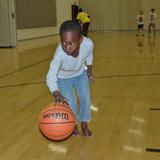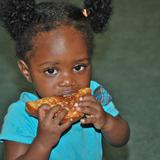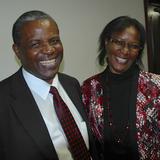It’s a bed that makes an enormous difference — an individual bed to sleep in as an alternative to a mat, a tarp or just plain dirt. After months, years and sometimes decades of wandering, of running, of confinement in refugee camps and of escaping, some very fortunate asylum seekers receive their first gift in Salt Lake City, Utah — a bed, complete with a mattress and a hand-tied quilt, as a symbolic beginning to their resettlement in the United States of America.
| Beds, constructed at Deseret Manufacturing, an arm of The Church of Jesus Christ of Latter-day Saints Humanitarian Center, are donated to community refugee agencies and distributed, along with a mattress and a hand-tied quilt, to resettlement families assigned to Salt Lake City, Utah. 2013 by Intellectual Reserve, Inc. All rights reserved. | 1 / 12 |
These beds come from Deseret Manufacturing, an arm of the humanitarian efforts of The Church of Jesus Christ of Latter-day Saints, and arrive in a cooperative effort with the city’s Catholic Community Services, the International Rescue Committee (IRC), the Refugee Immigrant Center-Asian Association of Utah and the Utah Department of Workforce Services refugee office.
The community agency-Church collaboration connects the refugee needs with services offered upon arrival.
“All of the agencies have a piece that combines to create a safety net for the refugees,” explains Amy Wylie, inner-city service missionary for the Church who is assigned to refugee services. “The challenges are so wide and so varied that if we didn’t work together, people would fall through the cracks. But despite the atrocities they have experienced, we have an opportunity to help them reclaim their lives in a safe and productive environment.”
There are currently 40 million displaced persons around the world, most in refugee camps, according to Brett Bass, manager of field operations in the Welfare Department who oversees the Church’s support of various refugee projects worldwide. Management of this issue falls on the shoulders of the United Nations high commissioner of refugees, and, says Bass, of that number, approximately 1,000 individuals journey to Utah each year, and some 50,000 have settled in Utah since the 1980s.
Due to their refugee or asylum status, newcomers receive a small federal stipend to assist in their immediate needs for housing and household supplies. They become legal residents after one year and are eligible for citizenship after five years.
“If they have to buy beds and bedding with that fund,” explains Patrick Poulin, executive director of the IRC, “their money doesn’t stretch that far. Having these household essentials donated by the Church helps the families really extend their budgets.”
But beds are only a small part of the services offered to these individuals as they arrive in Salt Lake City and attempt to build new lives. The Church partners with other agencies to provide housing and medical, educational and emotional support to the refugees. The Church has organized both an inner-city mission and language-specific branches of the Church to serve individuals and meet community circumstances. Service missionary couples support everyday family needs as they work within the inner-city boundaries.
“On arrival, a new family is assigned a case worker through the community agency,” says Aden Batar, director of volunteer and community relations at Catholic Community Services. “That case worker, usually a refugee themselves, helps them navigate the services available — from how to ride the bus to how to find a school or a grocery store. It’s a team effort — those with some local experience share that background with a newcomer.”
Finding those services becomes much easier when the refugees develop at least conversational use of the English language. Community resources offer English as a Second Language (ESL) courses, but a unique program established at the Church’s Humanitarian Center in 2009 offers the newcomers additional help. Some of the students referred by the community-sponsoring agencies can enroll in a job training program where they learn work skills and habits while studying English, says Doug Roberts, manager of rehabilitation and technical support at the Humanitarian Center.
“In a partnership with the government and a local school district, which provides certified ESL teachers, enrolled students participate in an intensive English language program four hours a day and then work an additional four hours,” explains Roberts. “That means they learn English much faster, but it also allows them to earn a wage for the full eight hours.”
Participation in the work training program also provides connections to internships and job placement, continues Roberts. “A job coach or mentor is assigned to each student on arrival; then a developmental specialist helps them address issues that arise in their transitions. It’s often surprising to see how quickly they learn to provide for their own needs. After all, they spent years learning how to survive and they are so grateful to start a new life with many choices available.”
Following the initial six months resettlement services provided for newcomers, families can turn to the Asian Association for longer term assistance, explains Lina Smith, director of refugee services there. “A case worker here can follow a family for up to five years if necessary, but we deal primarily with those who arrive in Utah on a second migration. They’ve settled someplace else for their initial time frame and then they have friends or family members who live in Utah, so they reunite with their acquaintances.”
The proximity and services of Deseret Industries and Welfare Square are also a great benefit to refugees settling in Utah.
Smith, Batar and Poulin, each with their individual community agency, access the resources of the Church’s welfare program to cover refugee family needs. Regardless of their religious affiliation, the families can be eligible for Church help.
“I’ve worked with the Church for many years," says Smith, “and without their assistance many refugees would be in a lot of trouble.”
“Most of our people are really coping well,” adds Batar, “but whatever we need, we know who to contact. I don’t hesitate to call or email when I have a need for diapers or laundry soap or whatever. The people at Welfare Square always say, ‘How much do you think you could use?’ and that makes a contribution to the success of the refugee resettlement here.”
For Poulin, the help goes beyond the Deseret Industries vouchers and beds. “The LDS Church sits at the table with us to help define strategies to serve the refugees most effectively. Their people serve on our advisory board and play a leadership role in how we can better serve in the community. That resource helps all of us define innovative programs to help families in a wide variety of circumstances.”
Go to the four links below to read personal accounts of some refugees.
